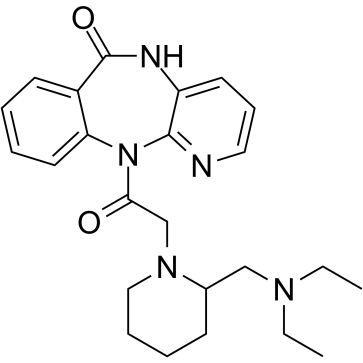Functional roles of muscarinic M2 and M3 receptors in mouse stomach motility: studies with muscarinic receptor knockout mice.
Takio Kitazawa, Kano Hashiba, Jinshan Cao, Toshihiro Unno, Sei-Ichi Komori, Masahisa Yamada, Jürgen Wess, Tetsuro Taneike
Index: Eur. J. Pharmacol. 554(2-3) , 212-22, (2007)
Full Text: HTML
Abstract
Functional roles of muscarinic acetylcholine receptors in the regulation of mouse stomach motility were examined using mice genetically lacking muscarinic M(2) receptor and/or M(3) receptor and their corresponding wild-type (WT) mice. Single application of carbachol (1 nM-30 microM) produced concentration-dependent contraction in antral and fundus strips from muscarinic M(2) receptor knockout (M(2)R-KO) and M(3) receptor knockout (M(3)R-KO) mice but not in those from M(2) and M(3) receptors double knockout (M(2)/M(3)R-KO) mice. A comparison of the concentration-response curves with those for WT mice showed a significant decrease in the negative logarithm of EC(50) (pEC(50)) value (M(2)R-KO) or amplitude of maximum contraction (M(3)R-KO) in the muscarinic receptor-deficient mice. The tonic phase of carbachol-induced contraction was decreased in gastric strips from M(3)R-KO mice. Antagonistic affinity for 4-diphenylacetoxy-N-methyl-piperidine (4-DAMP) or 11-([2-[(diethylamino)methyl]-1-piperdinyl]acetyl)-5,11-dihydro-6H-pyrido[2,3-b][1,4]benzodiazepine-6-one (AF-DX116) indicated that the contractile responses in M(2)R-KO and M(3)R-KO mice were mediated by muscarinic M(3) and M(2) receptors, respectively. Electrical field stimulation (EFS, 0.5-32 Hz) elicited frequency-dependent contraction in physostigmine- and N(omega)-nitro-L-arginine methylester (l-NAME)-treated fundic and antral strips from M(2)R-KO and M(3)R-KO mice, but the cholinergic contractile components decreased significantly compared with those in WT mice. In gastric strips from M(2)/M(3)R-KO mice, cholinergic contractions elicited by EFS were not observed but atropine-resistant contractions were more conspicuous than those in gastric strips from WT mice. Gastric emptying in WT mice and that in M(2)/M(3)R-KO mice were comparable, suggesting that motor function of the stomach in the KO mice did not differ from that in the WT mice. The results indicate that both muscarinic M(2) and M(3) receptors but not other subtypes mediate carbachol- or EFS-induced contraction in the mouse stomach but that the contribution of each receptor to concentration-response relationships is distinguishable. Although there was impairment of nerve-mediated cholinergic responses in the stomach of KO mice, gastric emptying in KO mice was the same as that in WT mice probably due to the compensatory enhancement of the non-cholinergic contraction pathway.
Related Compounds
| Structure | Name/CAS No. | Molecular Formula | Articles |
|---|---|---|---|
 |
Otenzepad
CAS:102394-31-0 |
C24H31N5O2 |
|
Acetylcholine activity in selective striatal regions support...
2009-01-01 [Neurobiol. Learn. Mem. 91(1) , 13-22, (2009)] |
|
Nucleus accumbens acetylcholine and food intake: Decreased m...
2009-01-01 [Behav. Brain Res. 198(1) , 252-7, (2009)] |
|
Loss of muscarinic and purinergic receptors in urinary bladd...
2010-10-01 [Urology 76(4) , 1017.e7-12, (2010)] |
|
Structural and functional neuroprotection in glaucoma: role ...
2010-01-01 [Cell Death Dis. 1 , e27, (2011)] |
|
BK channel β1 subunits regulate airway contraction secondary...
2011-04-01 [J. Physiol. 589(Pt 7) , 1803-17, (2011)] |